Related Research Articles
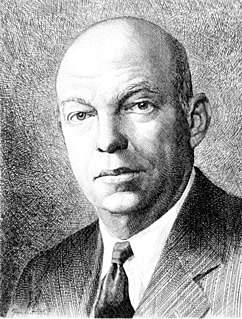
Edwin Howard Armstrong was an American electrical engineer and inventor, who developed FM radio and the superheterodyne receiver system. He held 42 patents and received numerous awards, including the first Medal of Honor awarded by the Institute of Radio Engineers, the French Legion of Honor, the 1941 Franklin Medal and the 1942 Edison Medal. He was inducted into the National Inventors Hall of Fame and included in the International Telecommunication Union's roster of great inventors.

John Logie BairdFRSE was a Scottish inventor, electrical engineer, and innovator who demonstrated the world's first live working television system on 26 January 1926. He went on to invent the first publicly demonstrated colour television system and the first viable purely electronic colour television picture tube.
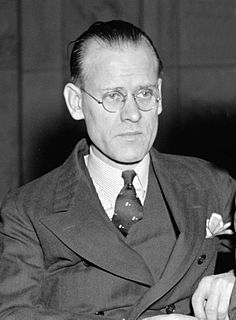
Philo Taylor Farnsworth was an American inventor and television pioneer. He made many crucial contributions to the early development of all-electronic television. He is best known for his 1927 invention of the first fully functional all-electronic image pickup device, the image dissector, as well as the first fully functional and complete all-electronic television system. Farnsworth developed a television system complete with receiver and camera—which he produced commercially through the Farnsworth Television and Radio Corporation from 1938 to 1951, in Fort Wayne, Indiana.
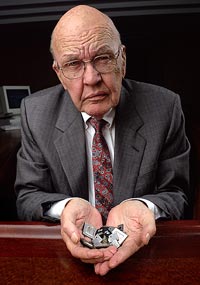
Jack St. Clair Kilby was an American electrical engineer who took part in the realization of the first integrated circuit while working at Texas Instruments (TI) in 1958. He was awarded the Nobel Prize in Physics on December 10, 2000. Kilby was also the co-inventor of the handheld calculator and the thermal printer, for which he had the patents. He also had patents for seven other inventions.

Vladimir Kosmich Zworykin was a Russian-American inventor, engineer, and pioneer of television technology. Zworykin invented a television transmitting and receiving system employing cathode ray tubes. He played a role in the practical development of television from the early thirties, including charge storage-type tubes, infrared image tubes and the electron microscope.
David J. Bradley is one of the twelve engineers who worked on the original IBM PC, developing the computer's ROM BIOS code. Bradley is credited for implementing the "Control-Alt-Delete" (Ctrl-Alt-Del) key combination that was used to reboot the computer. Bradley joined IBM in 1975 after earning his doctorate in electrical engineering from Purdue University with a dissertation on computer architectures.
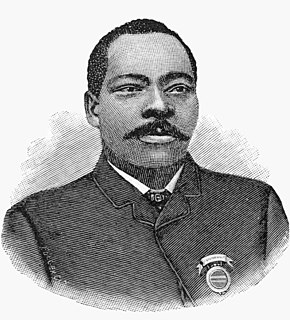
Granville Tailer Woods was an American inventor who held more than 50 patents in the U.S. He was the first African American mechanical and electrical engineer after the Civil War. Self-taught, he concentrated most of his work on trains and streetcars. One of his notable inventions was a device he called the Synchronous Multiplex Railway Telegraph, a variation of induction telegraph which relied on ambient static electricity from existing telegraph lines to send messages between train stations and moving trains. His work assured a safer and better public transportation system for the cities of the United States.

Ray Milton Dolby was an American engineer and inventor of the noise reduction system known as Dolby NR. He helped develop the video tape recorder while at Ampex and was the founder of Dolby Laboratories.

Alexander Stepanovich Popov was a Russian physicist, who was one of the first persons to invent a radio receiving device.
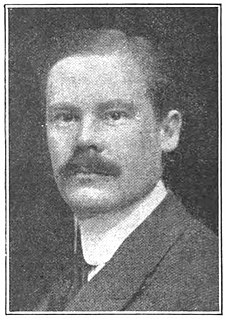
Ernst Frederick Werner Alexanderson was a Swedish-American electrical engineer, who was a pioneer in radio and television development. He invented the Alexanderson alternator, an early radio transmitter used between 1906 and the 1930s for longwave long distance radio transmission. Alexanderson also created the amplidyne, a direct current amplifier used during the Second World War for controlling anti-aircraft guns.

Games Slayter was a prolific U.S. engineer and inventor. He is best known for developing fiberglass, starting with a new method of producing glass wool in 1933.
George Harold Brown was an American research engineer. He was a prolific inventor who held more than 80 patents and wrote over 100 technical papers.
The timeline of radio lists within the history of radio, the technology and events that produced instruments that use radio waves and activities that people undertook. Later, the history is dominated by programming and contents, which is closer to general history.
David N. Crosthwait Jr. was an African-American mechanical and electrical engineer, inventor, and writer. Crosthwait's expertise was on air ventilation, central air conditioning, and heat transfer systems. He was responsible for creating heating systems for larger buildings such as Rockefeller Center and New York's Radio City Music Hall. He was granted an honorary doctoral degree in 1975 from Purdue University. In 1971, Crosthwait was elected as a fellow of the American Society of Heating, Refrigeration, and Air Conditioning Engineers (ASHRAE), making him the first African American fellow. Crosthwait was also named a fellow of the American Association for the Advancement of Science (AAAS).
Henry Thomas Sampson Jr. was an American engineer, inventor and film historian who created the gamma-electric cell in 1972 — a device with the main goal of generating auxiliary power from the shielding of a nuclear reactor.
Harold Alden Wheeler was a noted American electrical engineer.

The Elmore Family School ofElectrical and Computer Engineering (ECE) is the largest academic unit at Purdue University College of Engineering. The School of ECE offers both undergraduate B.S. degree as well as M.S. and Ph.D. graduate degrees in Electrical Engineering and Computer Engineering. The school enrolls over 1,900 undergraduates and over 1,300 graduate students. U.S. News & World Report ranks Purdue's Electrical Engineering and Computer Engineering 11th at the Undergraduate level [America's Best Colleges 2022]. The Graduate programs in both Computer Engineering and Electrical Engineering are ranked 9th [America's Best Graduate Schools 2023] The online MS program in Electrical Engineering is ranked #1 in the nation.
Benjamin Franklin Miessner was an American radio engineer and inventor. He is most known for his electronic organ, electronic piano, and other musical instruments. He was the inventor of the Cat's whisker detector.

Alan Howard was an American engineer, General Manager of the Gas Turbine Department at General Electric Co., and inventor. He was known as "one of the world's leading authorities on the development and application of gas turbines," and recipient of the 1964 ASME Medal.
Kaushik Roy is a researcher and educator in the area of electrical and computer engineering. He is a Fellow of the Institute of Electrical and Electronics Engineers and holds the position of Edward G. Tiedemann, Jr., Distinguished Professor of Electrical and Computer Engineering at Purdue University.
References
- ↑ "Prof. Roscoe Henry George (1896-1975) - Find A". Find a Grave .
- ↑ "Old Lafayette: Purdue had a role in early television". Journal and Courier.